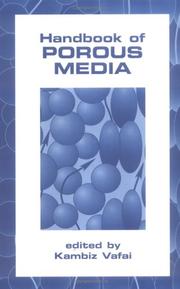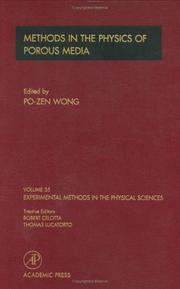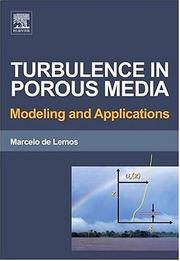| Listing 1 - 10 of 114 | << page >> |
Sort by
|

ISBN: 9786610204052 0585393540 1280204052 0203908694 9780585393544 9780824741501 0824741501 9780203908693 9780824788865 0824788869 0842788869 Year: 2000 Publisher: New York : Marcel Dekker,
Abstract | Keywords | Export | Availability | Bookmark
 Loading...
Loading...Choose an application
- Reference Manager
- EndNote
- RefWorks (Direct export to RefWorks)
General characteristics, modelling and geometric aspects of porous media; conduction in porous media; forced convection on porous media; natural and double-diffusive convection in porous media; mixed convection in porous media; radiative transfer in porous media; turbulence in porous media; drying, environmental and manufacturing applications in porous media.
Porous materials --- Porous media --- Materials --- Porosity
Book
ISBN: 3030853969 3030853977 Year: 2022 Publisher: Cham, Switzerland : Springer,
Abstract | Keywords | Export | Availability | Bookmark
 Loading...
Loading...Choose an application
- Reference Manager
- EndNote
- RefWorks (Direct export to RefWorks)
Porous materials. --- Porous media --- Materials --- Porosity
Book

Year: 2020 Publisher: Frontiers Media SA
Abstract | Keywords | Export | Availability | Bookmark
 Loading...
Loading...Choose an application
- Reference Manager
- EndNote
- RefWorks (Direct export to RefWorks)
The physics of porous media is, when taking a broad view, the physics of multinary mixtures of immiscible solid and fluid constituents. Its relevance to society echoes in numerous engineering disciplines such as chemical engineering, soil mechanics, petroleum engineering, groundwater engineering, geothermics, fuel cell technology… It is also at the core of many scientific disciplines ranging from hydrogeology to pulmonology. Perhaps one may affix a starting point for the study of porous media as the year 1794 when Reinhard Woltman introduced the concept of volume fractions when trying to understand mud. In 1856, Henry Darcy published his findings on the flow of water through sand packed columns and the first constitutive relation was born. Wyckoff and Botset proposed in 1936 a generalization of the Darcy approach to deal with several immiscible fluids flowing simultaneously in a rigid matrix. This effective medium theory assigns to each fluid a relative permeability, i.e. a constitutive law for each fluid species. It remains to this day the standard framework for handling the motion of two or more immiscible fluids in a rigid porous matrix even though there have been many attempts at moving beyond it. When the solid constituent is not rigid, forces in the fluids and the solid phase influence each other. von Terzaghi realized the importance of capillary forces in such systems in the thirties. An effective medium theory of poroelasticity was subsequently developend by Biot in the mid fifties. Biot theory remains to date state of the art for handling matrix-fluid interactions when the deformations of the solid phase remain small. For large deformations, e.g. when the solid phase is unconsolidated, no effective medium theory exists.
Periodical
Abstract | Keywords | Export | Availability | Bookmark
 Loading...
Loading...Choose an application
- Reference Manager
- EndNote
- RefWorks (Direct export to RefWorks)
Porous materials --- Porosity --- Porous media --- Adsorption --- Osmosis --- Permeability --- Materials --- Porosity. --- Porous materials.
Book
ISBN: 0128039116 0128038489 9780128039113 9780128038482 Year: 2016 Publisher: Amsterdam, [Netherlands] : Gulf Professional Publishing,
Abstract | Keywords | Export | Availability | Bookmark
 Loading...
Loading...Choose an application
- Reference Manager
- EndNote
- RefWorks (Direct export to RefWorks)
Porous materials --- Fluid dynamics. --- Permeability --- Mathematical models. --- Porous media --- Materials --- Porosity --- Dynamics --- Fluid mechanics
Book
ISBN: 1789230438 178923042X 1838813187 Year: 2018 Publisher: IntechOpen
Abstract | Keywords | Export | Availability | Bookmark
 Loading...
Loading...Choose an application
- Reference Manager
- EndNote
- RefWorks (Direct export to RefWorks)
This book discusses multiways in the porous materials. It involves materials with a large number of holes, and it highlights the synthesis, structure, and surface properties of porous materials closely related to more applications, such as support, catalyst, energy storage, chemical reactions, and optical applications. It studies the effect of the filling materials, the thermal treatments, and the porous density in the improvement of physical properties, electrical and energy efficiency, and the generation of new materials. Some synthetic process will be discussed with the effect of some parameters on the final characteristics of the prepared porous structures.
Porous materials. --- Porous media --- Materials --- Porosity --- Physical Sciences --- Engineering and Technology --- Materials Science --- Fluid Mechanics

ISBN: 0124759823 9786611023355 1281023353 0080524737 9780124759824 9780080524733 Year: 1999 Publisher: San Diego : Academic Press,
Abstract | Keywords | Export | Availability | Bookmark
 Loading...
Loading...Choose an application
- Reference Manager
- EndNote
- RefWorks (Direct export to RefWorks)
Over the past 25 years, the field of VUV physics has undergone significant developments as new powerful spectroscopic tools, VUV lasers, and optical components have become available. This volume is aimed at experimentalists who are in need of choosing the best type of modern instrumentation in this applied field. In particular, it contains a detailed chapter on laboratory sources. This volume provides an up-to-date description of state-of-the-art equipment and techniques, and a broad reference bibliography. It treats phenomena from the standpoint of an experimental physicist, whereby such
Porous materials --- Fluid dynamics --- Porous materials. --- Fluid dynamics. --- Dynamics --- Fluid mechanics --- Porous media --- Materials --- Porosity
Book
ISBN: 1634854748 9781634854740 9781634854528 1634854527 Year: 2016 Publisher: New York : Nova Publishers,
Abstract | Keywords | Export | Availability | Bookmark
 Loading...
Loading...Choose an application
- Reference Manager
- EndNote
- RefWorks (Direct export to RefWorks)
Porous materials. --- Fluid dynamics. --- Dynamics --- Fluid mechanics --- Porous media --- Materials --- Porosity

ISBN: 9780080444918 0080444911 0080456170 9780080456171 9786610640973 1280640979 Year: 2006 Publisher: Amsterdam ; London : Elsevier,
Abstract | Keywords | Export | Availability | Bookmark
 Loading...
Loading...Choose an application
- Reference Manager
- EndNote
- RefWorks (Direct export to RefWorks)
'Turbulence in Porous Media' introduces the reader to the characterisation of turbulent flow, heat and mass transfer in permeable media, including analytical data and a review of available experimental data. Such transport processes occurring a relatively high velocity in permeable media, are present in a number of engineering and natural flows. De Lemos has managed to compile, detail, compare and evaluate available methodologies for modelling simulating purposes, providing an essential tour for engineering students working within the field. - The hotly debated topic of heterogeneity and f
Turbulence --- Porous materials --- Heat --- Mass transfer --- Porous media --- Materials --- Porosity --- Mathematical models. --- Transmission
Book
ISBN: 0128221534 0128221151 9780128221532 9780128221150 Year: 2022 Publisher: Amsterdam, Netherlands ; London, England : Elsevier,
Abstract | Keywords | Export | Availability | Bookmark
 Loading...
Loading...Choose an application
- Reference Manager
- EndNote
- RefWorks (Direct export to RefWorks)
"Porous Carbons: Syntheses and Applications focuses on the fabrication and application of porous carbons. It considers fabrication at three scales: micropores, mesopores, and macropores. Carbon foams, sponges, and 3D-structured carbons are detailed. The title presents applications in four key areas: energy storage, energy conversion, energy adsorption, including batteries, supercapacitors, and fuel cells and environmental remediation, emphasizing the importance of pore structures at the three scales, and the diffusion and storage of various ions and molecules. The book presents a short history of each technique and material, and assesses advantages and disadvantages. This focused book provides researchers with a comprehensive understanding of both pioneering and current synthesis techniques for porous carbons, and their modern applications."--
Carbon. --- Porous materials. --- Porous media --- Materials --- Porosity --- Group 14 elements --- Light elements --- Carbon
| Listing 1 - 10 of 114 | << page >> |
Sort by
|

 Search
Search Feedback
Feedback About UniCat
About UniCat  Help
Help News
News